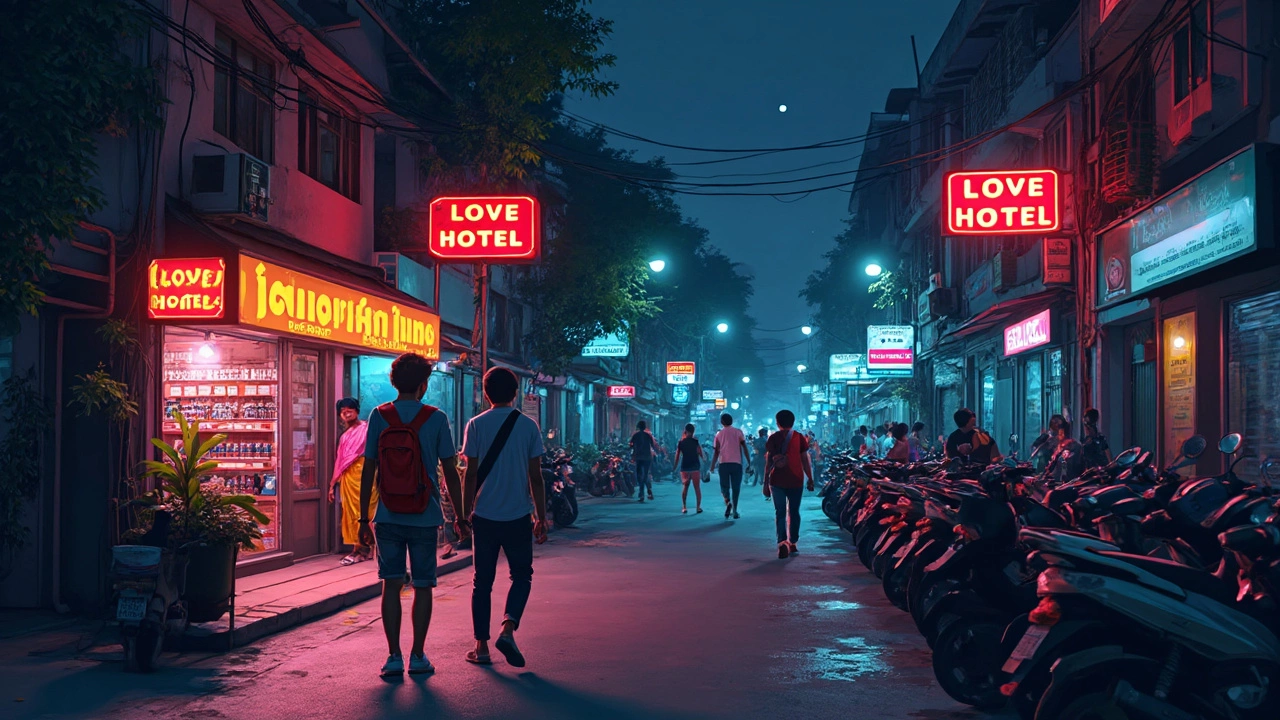Not long ago, booking a room for a few hours usually raised an eyebrow—or got you a polite but firm no from a hotel receptionist. Yet, in cities from Tokyo to São Paulo, 'love hotels' found clever ways to cater to guests looking for a bit of privacy, even if only for the afternoon. So, do these hotels still exist, or are they relics in a world that now relies on dating apps, social media, and endless other meeting points?
Walk down the dim side street of Shibuya on a Friday night, and it's hard to miss the pastel signs, twinkling like invitations, luring you inside establishments with whimsical names: 'Hotel Bunny', 'Palace of Hearts', or the oddly specific 'Hotel Good Time'. But love hotels weren't just a Japanese phenomenon—Latin America saw its own twist in the 'motel' culture, while parts of the US quietly maintained the practice behind frosted glass and discreet parking lots. What's surprising is how these places adapted, sometimes thriving with modern twists and sometimes fading as societal views shifted.
Where Love Hotels Began: A Peek into History
Love hotels aren’t a new thing. The first ones turned up in Osaka, Japan, after World War II. War left little space for privacy, and homes were small and crowded with relatives. People needed somewhere to sneak away. Early hotel owners saw the need and filled it, painting their buildings vividly to stand out by night. The idea was simple: anonymous, affordable, and always available, with a side of cheeky creativity in the room decor. In time, love hotels spread through Asia, South America, and even Europe—each with its regional twist.
Look at Brazil, where 'motels' became the go-to for young couples unable to afford their own place or escape watchful parents. They offered themed rooms, round beds, mirrors on the ceiling—sometimes even heart-shaped bathtubs. In Japan, you’d find everything from Hello Kitty suites to underwater fantasy rooms. It wasn’t just about the physical space. It was a social workaround, a pressure valve for cultures that still frowned on sex before marriage or public displays of affection.
As society grew more open, love hotels started losing some customers, sure. But they stayed for one big reason: privacy, plain and simple. If you’re in a city where homes are tiny and walls are paper-thin—like most Tokyo apartments—a love hotel offered a level of comfort and secrecy no regular flat could. Even married couples checked in now and then, just to break up the routine or escape the kids for a night.
Of course, the concept also made its way into pop culture. Watch any Japanese drama or a K-pop music video, and chances are, you’ll spot a flashy love hotel neon sign in the background. Studies showed that in the early 2000s, Japan had about 37,000 love hotels pulling in 40 million visits each year. Here’s a quick table of love hotels by selected country and peak operating years:
| Country | Estimated Number | Peak Years |
|---|---|---|
| Japan | ~37,000 | 2000s |
| Brazil | ~5,000 | 1980s – 2000s |
| South Korea | ~20,000 | 1990s – 2000s |
| United States | Unknown | Niche/region-specific |
This isn’t ancient history, either. The demand never entirely dried up; it just evolved.
What Love Hotels Look Like Today
Picture this: You walk into a building with no front desk staff, just a little screen and a menu of rooms—a robot handles your booking. You pay cash or card, tap a button, and a key slides out. That’s how many modern love hotels operate, especially in Japan. Privacy is the supreme currency. You rarely see another guest, and staff interactions are minimal. But the rooms? They still go all out. There are karaoke machines, tubs big enough to swim in, vending machines with, well, just about anything you can imagine.
Aisling would laugh if I dragged her into one of the more over-the-top fantasy suites, but it’s actually pretty normal for couples to celebrate anniversaries there. Some hotels in Tokyo even run seasonal contests for best room concept—think cherry-blossom Jacuzzis in spring or spooky Halloween décor in October. Room rates usually go by the hour ('rest') or overnight ('stay'). An average 'rest' time in central Tokyo runs from ¥4,000 to ¥8,000 (£20–£40), depending on location and fanciness.
Europe tried the idea, but it never really took off like in Asia or South America. There are a few in Paris, and one or two hidden in places like Berlin and London, but they tend to brand themselves as “romantic hotels” or “boutique stays” and drop the secrecy. It’s practical, really—the difference between a love hotel and a regular hotel is often just the price, layout, and how fuss-free everything is. Motels in the US, especially in out-of-the-way places, still serve the same function for people needing a quick rendezvous away from prying eyes.
You’ll also find a tech-friendly crowd booking time in these hotels now. Some places jazz things up with app-based entry, themed playlists, or room-service robots. Flexible working? Turns out that’s a boon for short-stay hotels too, with a surge in daytime business bookings by freelancers who want peace that coffee shops don’t offer.
Despite society getting more open about sex and relationships, privacy is still a hot commodity. Maybe there’s just something about slipping quietly behind a mirrored door that makes everyday life feel more like a movie scene, even if only for an afternoon.

Who Uses Love Hotels—and Why?
Talking about love hotels gets everyone thinking about secret trysts and extramarital affairs. Yeah, that still happens. But that’s just a sliver of the story. The client list is surprisingly diverse. Students living at home rent a room to get some alone time with their partner. Married couples with kids, desperate for a night off from the chaos, book in for a night or even a quick midday break. There are even package deals that come with room service, breakfast, and champagne deliveries—so much for seedy stereotypes.
Travelers find love hotels handy for the same reason locals do—they’re central, usually cheaper than business hotels, and nobody bats an eyelid if you show up alone, as a couple, or in a small group. In places like Rio de Janeiro, some love motels have become honeymoon destinations, with multiple-room suites and rooftop pools. It’s about discretion, sure, but also about indulgence that regular hotels don’t quite offer. Themed rooms can be hilarious or jaw-droppingly impressive—picture a suite decorated like a spaceship or a full-on tropical rainforest, complete with sound effects.
Sex isn’t always the reason guests check in. Some people just crave peace, quiet, and a huge bathtub. In Japan, love hotels recorded a sharp rise in female solo travelers booking rooms for personal retreats, away from noisy neighbors or awkward roommates. One Tokyo hotel reported that nearly 40% of its weekday guests were women traveling alone—often seeking a soak and Netflix marathon rather than anything spicy.
Here's where things get interesting: In the 2020s, pandemic rules kicked demand up a notch, as people looked for socially distanced ways to meet. Hourly hotels everywhere—whether branded as love hotels or not—offered a sort of 'bubble' service. You could check in, stay clean, and leave without crossing paths with others.
For someone like me, happily married to Aisling in Dublin, love hotels are mostly the stuff of travel stories now. But on our trip to Seoul, we tried one for the novelty—and I’ll tell you, there’s something to be said for the sheer harmless fun of a disco-lit bathroom and on-demand karaoke in your pajamas. Sometimes, you just want to feel like you’re starring in your own glam pop video, minus the paparazzi.
Are Love Hotels Here to Stay—and How to Find One
So, are love hotels a dying breed, or just quietly living on in the background? It’s a bit of both. In places like Japan, the numbers have dipped from their peak, thanks to people renting their own spaces and culture shifting. Yet, there’s a solid core of business for privacy and adventure—something boring chain hotels can’t match. In Latin America, love hotels are holding steady, quietly updating their styling to keep pace with modern tastes, and you’ll see more cheeky ads pitching weekend 'daycations' alongside the traditional after-dark crowd.
If you want to try a love hotel, you’ll need to do a little homework. They’re all about the no-fuss vibe—rarely advertising street addresses, often listing only an area or nearest station. Most have basic websites with photos and pricing but probably won’t show up on big travel booking engines. Try searching 'love hotel' or 'motel' plus the city you’re in; TripAdvisor forums and Reddit threads are goldmines for reviews. In Japan, app-based maps show properties ranked by anonymity, cleanliness, and theme (who knew 'jungle adventure' was so specific?).
Here are some tips if you’re curious:
- Check pay systems—some are still cash only, others have contactless card options.
- Book discreetly—don’t expect big signs or hotel chains. Go with word-of-mouth and online forums.
- Pick your time—weeknights are quieter and often cheaper.
- Try something silly—if you’re there, you might as well choose a themed room and embrace the kitsch.
- Mind the rules—no big groups, and some hotels turn away solo travelers. If it’s your first time, treat the staff and privacy protocols with respect.
It boils down to this: Love hotels aren’t just about quick flings anymore. They’re about carving out a bubble of privacy, swapping routine for a dash of escape—whether with a partner, friends, or on your own. The signs might be quieter now, and the decoration a bit subtler, but for anyone searching out a slice of discreet adventure, they’re still out there, neon lights twinkling just off the main street. And honestly, who can say no to a giant bathtub and zero questions asked?
